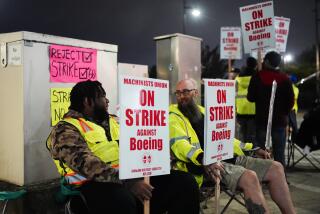NEWS ANALYSIS : Potholes Abound for GM : Strike Settlement Doesnât Mean Road Is Clear
DETROIT â A decade ago, then-General Motors Corp. board member Ross Perot quipped that changing the auto maker was akin to getting an elephant to dance. Judging from the most recent three-day strike against GM, the nationâs largest auto maker is still tripping over its own feet.
A settlement was announced late Friday, but not before nearly 37,000 workers were idled in 10 assembly and parts plants. The strike involved 6,600 United Auto Workers union members who walked out of a Flint, Mich., parts plant this week in a dispute over hiring, overtime and job security.
At a news conference, union officials said a tentative agreement was reached but declined to provide details pending ratification by members of UAW Local 651 on Sunday. It could still take several days to resume production at some plants, costing GM millions of dollars in lost sales.
The latest strike was the sixth against GM in less than a year and came as the company is struggling to turn around its key North American automotive operations. The labor discord underscores the difficulties GM is facing in becoming a more nimble, efficient auto maker and in changing a once-stodgy corporate culture.
More importantly, the dispute came at a time when GM can least afford it. The company has been unable to build enough of its most popular vehicles and production lost due to the strike will hit the bottom line.
âIt adds up pretty quickly when you lose production of vehicles that you can make $4,500 a piece on,â said Nicholas Lobaccaro, analyst with S.G. Warburg.
Despite Fridayâs agreement, there is no end in sight to the labor strife. Industry experts expect more plant walkouts to hamper the auto maker this year because four other UAW locals have sought approval from the international union to strike GM.
The latest dispute came just as the company is recovering from the impact of short walkouts at its Buick City complex in Flint in September and an Anderson, Ind., parts factory in August. Those disputes were major reasons why the companyâs North American operations lost $328 million in the third quarter.
That third-quarter performance raised questions of whether GMâs painful two-year restructuring is losing momentum. Company officials insist that is not the case.
âOur fundamental turnaround strategies are sound and we are on track to achieve them,â said John F. Smith, GMâs chief.
Analysts agree that the restructuring is progressing, but say the recent setback shows the magnitude of GMâs problems. GM still takes longer to build a car than Ford or Chrysler, and makes less on each vehicle than its rivals.
The auto maker lowered operating costs sharply in 1992 and 1993 by closing factories, laying off workers and forcing suppliers to lower prices. Further gains will require more difficult changes to internal processes and systems.
Such moves take time and are often resisted by its aging, unionized work force. The recent slow model launches of the Chevrolet Cavalier and Lumina demonstrate the difficulties of streamlining.
With U.S. auto sales up 9% in each of the last two years, GM has tried to boost production even while closing inefficient plants and reducing its hourly work force by 15%. This required running lines faster and on overtime.
Recent strikes, such as the one at the AC Delco Flint East facility, revolved around the issue of too much overtime, the companyâs reluctance to hire new workers and its desire for more âoutsourcingâ--hiring non-union contractors to supply parts.
One reason GMâs costs are so high is that it makes 70% of its parts with union workers. UAW wages and benefits are about $47 an hour, nearly double what some non-union companies pay. Ford makes about half of its parts, Chrysler only 30%.
The UAW is adamantly opposed to contracting out work, saying it threatens union workersâ jobs. The union wants GM to hire more workers to meet increased production demands and to reduce overtime.
At the Flint plant, which makes filters, fuel pumps, cruise control units and instrument panels, striking union members complained of the stress of 50- and 60-hour weeks. âPeople are getting run ragged with overtime,â said Chuck Sain, a veteran union worker.
Analysts, however, expected the dispute to be settled quickly because it had the potential of shutting down most of GMâs assembly operations within a week, including those that make such popular and profitable vehicles as the Chevrolet Suburban and full-sized pickup trucks.
GMâs tumultuous labor relations are in stark contrast with Chrysler and Ford, both of which have avoided any major strikes in the last five years.
(BEGIN TEXT OF INFOBOX / INFOGRAPHIC)
GMâs Strikes
General Motorsâ workers have walked off the job six times in the past year.
* January, 1994: About 2,300 workers strike for six days at a Shreveport, La., compact pickup truck plant.
* March, 1994: More than 3,200 employees walk off the job for three days at two Delco Chassis brake-making plants in Dayton, Ohio.
* June, 1994: About 3,500 designers at GMâs technical center in Warren, Mich., strike for three days, over outside contractors.
* August, 1994: More than 3,500 employees strike two days at GMâs Inland Fisher Guide plant in Anderson, Ind.
* September, 1994: A strike by 11,500 workers at GMâs 123-acre Buick City complex in Flint, Mich., causes three additional plants to close.
* Jan. 18, 1995: About 6,600 workers walk out of a Flint, Mich. plant, causing nine GM assembly plants to shut down. It was settled on Friday.
Sources: Times reports, wire reports. Researched by JENNIFER OLDHAM / Los Angeles Times






